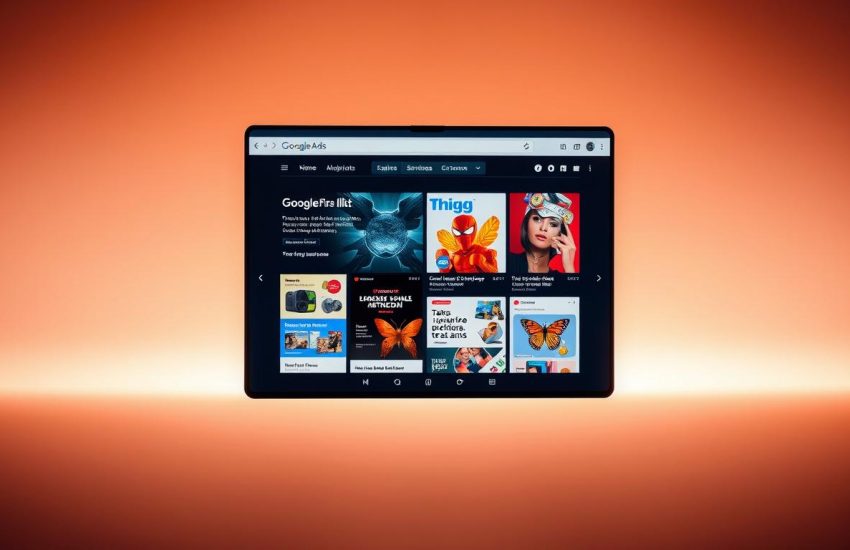Have you noticed how fast users move from search to decision on their phones? We see more than half of searches happen on handheld devices. That shift changes how google ads must perform.
We’ll show a clear plan to reshape campaigns, creative, and measurement so your ads meet users where they act fast. Expect practical steps on assets, copy, keywords, landing alignment, bidding, and analytics.
Data matter. When pages and campaigns match intent, businesses win: more qualified traffic, higher conversion rates, and lasting quality that improves performance over time.
In this piece, we explain what platform controls changed, where gains appear across the funnel, and how to prioritize fixes that move results—not just settings that look good on paper.
Key Takeaways
- Align campaigns to the quick intent of users to lift conversion rates.
- Restructure creative and assets for faster relevance and clearer calls to action.
- Measure quality, not just clicks, to improve long-term performance.
- Prioritize fixes that drive business outcomes over cosmetic adjustments.
- Follow a step-by-step plan for keywords, landing pages, bidding, and analytics.
Why Mobile-First Matters Right Now
When searches happen on the go, ads need to deliver instant clarity and a direct path to conversion. Short sessions and fast intent mean you have seconds to prove relevance.

Shifts in search behavior on mobile devices
More than half of searches now start on small screens. People spend most of their digital time on handheld devices, and that concentrates intent into short windows.
Users expect quick answers. They tap through fewer links and choose brands with clear value and fast pages.
Impact on traffic, conversions, and business outcomes
Higher purchase rates on phones and faster local searches mean paid campaigns can drive immediate revenue when aligned to intent.
- Traffic: More volume from short queries and nearby intent.
- Conversions: Faster decision windows increase conversion when paths are clear.
- Risk: Slow or confusing pages raise bounce and waste spend.
We tie these signals to measurable goals so you can track lift in traffic quality, conversion rate, and downstream revenue from your google ads strategy.
What’s Changed in Google Ads for Mobile
Platform controls evolved. In 2014, device-specific targeting was constrained. Advertisers adjusted bids instead of creating separate segments. Today, controls are simpler and let us design campaigns around handheld devices with intent in mind.

From targeting limits to simpler controls
We now build a campaign that treats on-the-go users as a primary group. That means focused creative, adjusted bids, and clearer asset use. It also reduces the need for complex workarounds.
Effectiveness across the funnel
Data shows improved performance up and down the funnel. Comscore finds mobile ads outperform desktop. Case studies back this: Shutterfly saw a 60% jump in conversions on non-brand terms. Caserola gained 300% in conversion rate after reconfiguring campaigns.
| Brand | Change | Result |
|---|---|---|
| Shutterfly | Campaign rework for handheld devices | 60% increase in mobile conversions |
| Caserola | Campaign restructuring and bids | 300% rise in conversion rate |
| Vegis | Mobile-focused AdWords campaigns | 146% increase in conversions |
| Event Tickets Center | AMP vs responsive setup | 100% more clicks to AMP |
- Action: Split campaigns by intent, not just device.
- Measure: Track device signals and conversion paths to attribute results correctly.
- Roadmap: Migrate legacy structures gradually to avoid volume loss.
Mobile Optimization Google Ads: A Step-by-Step Game Plan
Pick the most valuable conversion for your business and align your ads and landing pages to that outcome. That single choice simplifies priorities and guides every campaign decision.
Define one primary action—calls, store visits, leads, or purchases. Map each campaign and ad group to that action so metrics reflect business value, not vanity.
Structure campaigns and ad groups for intent
- Segment campaigns by intent: near-me and urgent searches versus research queries to keep ads relevant to users.
- Use 2–4 responsive search ads per ad group and align keywords, ad text, and landing copy to the chosen action.
- Set budgets and bid plans around typical search windows, then ladder targets to cost-per-action thresholds.
- Create clear naming conventions so campaign and ad group performance is visible and manageable at scale.
- Maintain negative keyword hygiene and match types to capture high-intent traffic while filtering noise.
Connect each ad group to a focused landing experience that minimizes friction and shortens the path to action on small screens. This pairing drives better performance and more predictable business outcomes.
Use the Right Mobile Ad Assets and Extensions
The right extensions bring extra business details into search results without extra ad spend. They cut steps for users and lift performance when we match assets to intent.
Sitelinks route users to exact pages—hours, best sellers, or a product page. That reduces taps and improves conversion from ad to landing.
Location assets show a map, address, and distance to your store. Use them to drive foot traffic and short decision windows.
Call extensions add a visible phone number and can raise CTR by 4–5%. Call-only ads work when a live conversation is the primary conversion.
- Schedule call extensions during business hours.
- Layer sitelinks, callouts, and price extensions to increase SERP share.
- Track which combinations improve CTR and conversion rates, then scale winners.
| Asset | Primary Benefit | Best Use |
|---|---|---|
| Sitelinks | Fewer taps to specific pages | Promotions, hours, product pages |
| Location extensions | Shows map and distance | Local offers and store visits |
| Call & call-only | Direct phone contact from search | Service bookings and urgent requests |
Write Mobile-First Ad Copy That Converts
Good ad copy turns a quick search into a confident click and a clear next step.
Keyword-infused, compelling headlines for small screens
We front-load keywords into tight headlines so users see relevance immediately. Keep headlines to one idea: product, benefit, or price.
Tip: Use the top keyword and a clear benefit in the first 30 characters.
Clear, strong calls-to-action that match user intent
Use direct CTAs—Buy Now, Call Today, Get a Quote—that set expectations. One primary call per ad reduces friction.
Match the CTA to the desired action so users get the next step they expect after the click.
Descriptions that highlight unique value and specific offers
Describe what makes you different: selection, price, same-day service, or an exclusive deal. Add time-bound language to move users faster.
Testing multiple ad variations to improve performance
Rotate 2–4 ad variations per ad group. We let higher-performing text run more while we gather insights.
Test headlines, CTAs, and value statements. Track which ads lift conversion rates and iterate.
- Front-load keywords and benefit in headlines.
- Use one clear CTA per ad to avoid choice overload.
- Highlight differentiators and limited-time offers in descriptions.
- Run 2–4 variations and scale the best performers.
| Copy Element | Best Practice | Why it Works |
|---|---|---|
| Headline | Keyword + benefit, concise | Instant relevance; higher CTR |
| CTA | Direct single action (e.g., Call Today) | Clear expectation; higher conversion rates |
| Description | Unique value + time-bound offer | Builds urgency and trust |
| Variations | 2–4 per ad group | Data-driven performance gains |
Keyword Strategy for Mobile and Voice Search
Focusing on proximity and urgency phrases captures searches that expect immediate results.
We target “near me,” “open now,” and “same-day” patterns to reach users who plan to act within an hour or are nearby. This sharpens relevance and cuts wasted clicks.
Build ad groups around conversational queries. Long, 5+ word phrases often indicate voice input. Group these by intent so your ads mirror the way people ask questions aloud.
Mine Search Query Reports and Search Console regularly. The data reveals high-value long-tail search terms that you can fold into ad copy and negatives.
- Separate discovery vs decision searches so budgets fund the terms most likely to convert.
- Start modest—expand as data validates new themes and incrementality.
- Use match types and negatives to protect spend while keeping scale.
Review query data weekly at launch. That cadence speeds learning and informs creative, landing, and bid choices over time.
| Focus | Why it Matters | Action |
|---|---|---|
| Immediacy terms | Users expect quick results | Bid higher; craft urgent CTAs |
| Conversational queries | Reflects voice search patterns | Create dedicated ad groups |
| Search Query Reports | Source of long-tail terms | Mine weekly; add negatives |
Landing Pages That Match the Mobile Ad and Goal
A landing page must echo the ad’s promise and guide users to one clear action. We design pages so visitors feel they arrived in the right place. That trust shortens the path from click to conversion.
Message match: mirror the offer and CTA
We repeat the offer, CTA, and main keywords from the ad on the page. This reduces doubt and raises conversions.
Placement matters: headline, hero CTA, and a short reinforcing line keep continuity intact.
Speed, clarity, and thumb-friendly actions
Pages should load in roughly three seconds or less; slow pages lose users fast. We favor lightweight builds and selective media to preserve speed.
Buttons are large, forms are short, and primary actions sit above the fold so users can act with a thumb.
Design for specific outcomes
We tailor landing pages by goal: click-to-call layouts for calls, short lead forms for signups, simple carts for purchases, and maps for store visits.
- Proof near the CTA: price, reviews, and trust badges reduce hesitation.
- One-page focus: limit distractions and point users to the specific product or action.
- Performance-first: AMP or performance-focused builds can lift quality score and conversion performance.
Bidding, Scheduling, and Device Strategy for Mobile Campaigns
A focused bidding plan puts budget where conversion rates and proximity signal the strongest intent. We align bids and schedules to the moments and places that drive real results.
Bid adjustments by device to capture profitable traffic
We apply device-level bid adjustments to favor devices with higher conversion rates. When a device proves profitable, we raise bids to win top positions.
Dayparting based on when searches convert
Schedule campaigns to match peak times. Use dayparting to concentrate spend when users convert most often. Track cost-per-action by hour, then tighten or loosen bids.
Location signals and proximity to improve relevance
Geo modifiers push budget nearer stores and service areas. Local searches are growing fast; bidding by location reduces wasted spend and lifts traffic quality.
- Segment campaigns where behavior differs across devices and places.
- Monitor impression share and absolute top rates during peak times.
- Make decisions from conversion and revenue data, then document outcomes per campaign.
“We base bid and schedule choices on data, not assumptions.”
Measure, Learn, and Improve Quality Score on Mobile
We focus measurement on the signals that matter so you can lift ad relevance and landing performance quickly.
Quality score ties three clear signals to how your campaigns perform: ad relevance, expected CTR, and landing page experience. We break those into testable items so fixes produce real results.
Connect ad relevance, landing page experience, and CTR
Match headlines to page content. That improves expected click rates and the overall score.
Extensions and call assets matter—extensions can lift CTR by 10–15% and call assets add about 4–5%.
Track calls, store visits, and cross-device conversions
Count phone calls with forwarding and event tracking so you don’t underreport conversions.
Attribute store visits where eligible and add cross-device paths to capture journeys that start on phones and finish elsewhere.
Iterate with data: assets, keywords, and page speed
Use segment diagnostics in google ads to see which element limits your score and fix it first.
- Test assets and headlines; keep winners.
- Refine keywords and negatives from query data.
- Speed up the landing page to reduce friction and boost quality.
“We set reporting that ties metrics to revenue so decisions reflect business outcomes.”
Conclusion
Start with one clear outcome. Pick a call, store visit, lead, or product sale and design every campaign and landing page to serve that action. Small changes add up: extensions can lift CTR 10–15% and call assets often add another 4–5% to direct contact.
Audit your site speed and confirm message match on each landing page. Deploy the highest-impact assets first. Then restructure campaigns around user intent and set up tracking for phone and cross-device conversions.
We recommend steady iteration: test bids by device and time, refine keywords, and measure quality score gains. Do this and your business will see measurable results from mobile ads that give people what they need—fast.


